Further
studies of a “lotus flower” which was drawn in crops at Macmillan
Way on April 19, 2015, and its possible relation to a 6.6-magnitude
earthquake, one day later near Taiwan
A new
crop picture at Macmillan Way on April 19, 2015 was laid down very
delicately in the field, without any noticeable signs of local human
construction. Several insightful comments by Graham Timmins (see
fieldreports)
or Mat Gyro (see
comments),
after they inspected this crop picture first-hand on the ground,
were as follows:
“When
flying (the drone) low to the ground, there appeared to be very
little damage to the crop. In fact, it looked as though the crop was
still very much alive, unlike in normal circles which we visit,
where plants have been crunched into the ground, or have died.”
“None of
the leaves were flattened to the ground, and very few were even bent
or depressed. Rather, some leaves within this crop pattern were just
slightly wilted, and tinged with pale brown or yellow edges, almost
as if they had been slightly scorched. The affected leaves were
often just one or two, out of a whole clump of leaves from one
plant. Neighbouring leaves remained untouched. Worth a visit,
especially for anyone who still thinks crop circles are made with
planks and bits of string!”
Primary
criteria for assessing any new crop picture as “human made” or “not
human made”
When
studying any new crop picture, and assessing its possible origin as
“human made” or “not human made”, a close inspection of the
patterned crop, before any visitors have walked on it, is
essential (see for example
Fringe2014review or
fringe2014x or
fringe2015b). We know
what human-made crop pictures look like, and how long it takes for a
team of experts to make one, while using rope and boards (see
fringe2013s). For
human-made crop pictures, the patterned crop is generally crushed or
flattened to the ground, because one of more human crop artists have
planked it down with force, or have walked on it. In this case,
quite to the contrary, the first investigators saw very little
damage to the patterned crop, and certainly no “crushing” or
“flattening”.
Because
this small crop picture seems not to have been made by
local humans on the ground, and because its nearby landscape images
seem to have anticipated a 6.6-magnitude earthquake one day later
near Taiwan (see
taiwan-earthquake), then
it is worth a careful study. Future knowledge of an earthquake is
something that no ordinary person, living on Earth today, could
possibly achieve (see slides near the top of
comments).
Landscape concerns are also important when studying new crop
pictures, since these images appear meant to be seen from space.
The
beautiful image of a “lotus flower”
Our best
aerial image of the new crop picture at Macmillan Way is shown
below, thanks to excellent drone photography by Mr. and Mrs. Gyro
(see
the-flower-of-life):
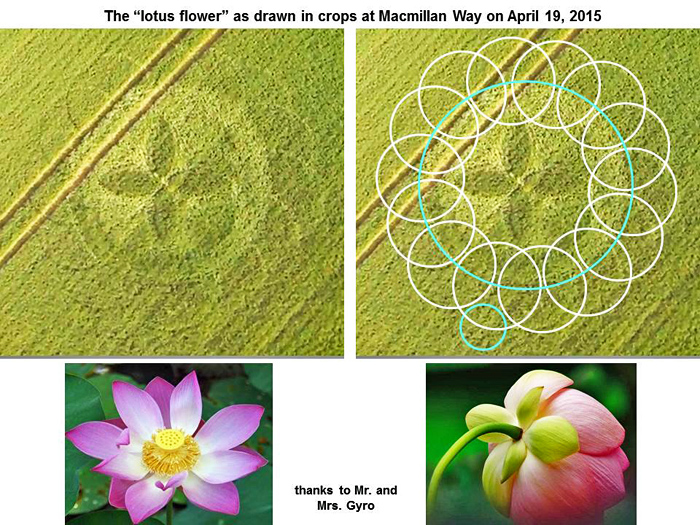
We can
see right away that it resembles a “flower”, but other details are
hard to discern without careful study. This is because those
winter-wheat plants were shaped delicately by unknown energies,
without any “flattening” or “crushing” as for human-made crop
pictures.
With the
help of Anne Stallybrass, I carefully placed white or blue circles
over various features of this new crop picture, to help us see them
more clearly. This overlay is shown on the right above. Our
immediate impression is that of a “lotus flower”.
Any
lotus flower shows two rows of staggered, overlapping “petals”
around the outside, just as seen in the crop picture. Any lotus
flower also shows a large, round “pod” in its centre which holds
seeds. Finally any lotus flower shows four oval-shaped leaves or
“sepals”, just below its many petals. These resemble four “oval”
shapes which were drawn in the crop picture near its centre, in the
shape of a cross.
Do the
extra-terrestrials regard us as “lotus eaters”?
When we
looked in the landscape to see where this crop picture was drawn,
using Google Earth, we got a real surprise! There we can see the
image of a man with “short-cropped hair”, “two eyes” and a “beard”,
who is eating a “lotus flower”:

This new
crop picture was drawn just next to the man’s “mouth”. Such a
humorous image reminds us of the story of “lotus eaters”
from ancient Greece. “Lotus
fruits and flowers were a primary food of the island, and were
narcotic, thereby causing people to sleep in peaceful
apathy”
(see
Lotus-eaters).
Do the extra-terrestrial crop artists think that Earth humans are
like “lotus eaters”? Do we metaphorically “sleep in peaceful
apathy”, while eating good food, drinking alcohol or watching TV? Do
we seldom concern ourselves with serious matters, or with potential
dangers that might arise?
Looking again at the man who is “eating a lotus flower” in the slide
above, we can see that his body has been “broken in half” at the
waist due to some trauma. One of his two feet have been “twisted
backward”. Yet he seems not to care, because he is without cares as
a “lotus eater”!
Landscape image of a “Buddhist monk” off the “coast of China”
Looking
further away in the landscape, using Google Earth, we found next the
image of a “Buddhist monk praying” off the “coast of China”:

This was
where a 6.6-magnitude earthquake struck on the following day of
April 20, 2015, just slightly east of Taiwan (see a “red teardrop”
in the slide above).
A “lotus
flower clock”?
Studying
the new crop picture more carefully, we can see 14 large “white”
circles around the outside. When combined with one large “blue”
circle in the centre, and with one small “blue” circle below, we can
count 30 symbols in total around the outside:
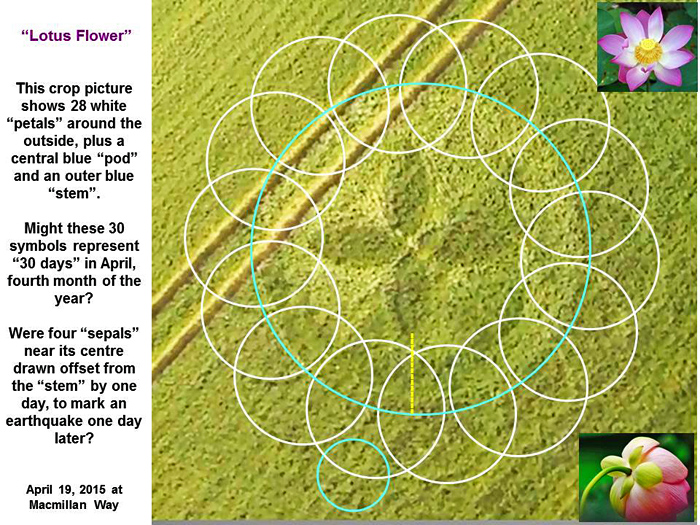
There
would be 28 “flower petals” in total (arranged into two staggered
rings of 14), one central “seed pod”, and one outer “thin stem”.
Such artistic details are evidently meant to describe a “lotus
flower”.
More
surprisingly, we can see that four central “sepals” were drawn
slightly offset from its outer “thin stem” by an angle
of (360o/ 28) = 13o. This crop picture
appeared during April, so we might associate “four” inner sepals
with a “fourth” month of the year. Likewise we can count 30 symbols
in total around the outside, as 28 “petals” plus a central “seed
pod” and an outer “thin stem”. There are 30 days in the month of
April. Might those 30 outer symbols represent “30 days”?
If this
interpretation is valid, then a slight offset of four inner “sepals”
from an outer “thin stem” (marked by a yellow line in the slide
above) could suggest “one day”. There was a
6.6-magnitude earthquake near Taiwan, just one day after this crop
picture appeared. Furthermore, this crop picture was drawn in the
broad landscape context of a “Buddhist monk”, who appears to be
praying just off the “coast of China”.
A more
definite elaboration of the “lotus flower clock” is shown below. By
this hypothesis, the crop picture in its entirely might represent
“month 4 of April, days 9 to 30”, plus several days in May:
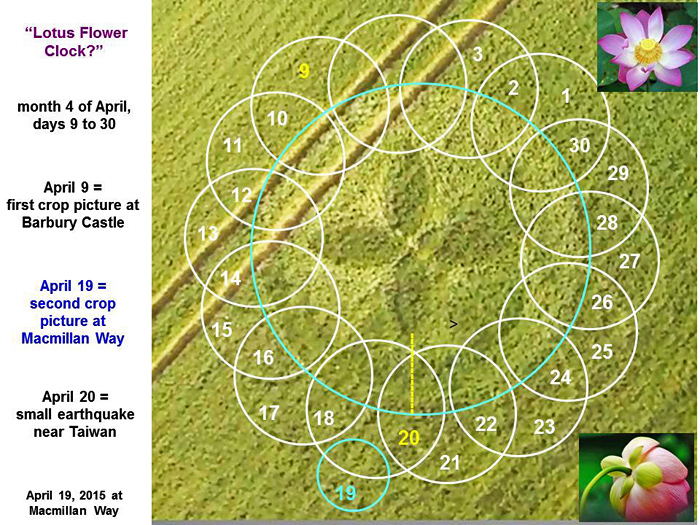
We would
start counting on day 9 (marked in yellow), when the first crop
picture of 2015 appeared near Barbury Castle. The second crop
picture of 2015 then appeared on day 19 (marked in blue) at
Macmillan Way. Finally on day 20 (marked again in yellow), there was
a 6.6-magnitude earthquake near Taiwan. What might happen as we
proceed into the month of May?
Can we
find any other evidence to support the “earthquake” interpretation?
This is
an interesting hypothesis, but can we find any other evidence, which
might link the crop picture of April 19 to specific pre-knowledge of
an earthquake, one day later on April 20? Well, when we “flip” the
image of this crop picture in its landscape setting by 180o,
we can see the slightly humorous image of a man “falling backwards
into a hole” during an earthquake:
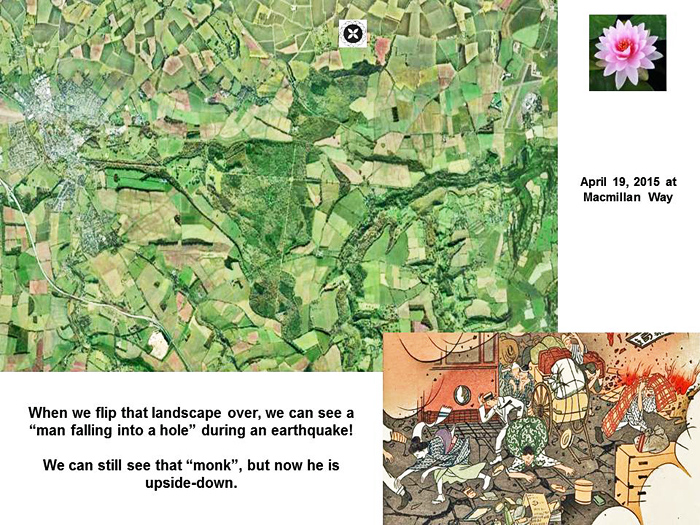
How
clever is that? We can still see the “Buddhist monk praying”, but
now he appears upside-down. The force of explosion of an
“earthquake” is suggested by a large, white “explosive” motif at
centre left.
Thinking
about the beached dolphins?
In this
“flipped over” view, the new crop picture at Macmillan Way was drawn
just over that falling man’s “head”:
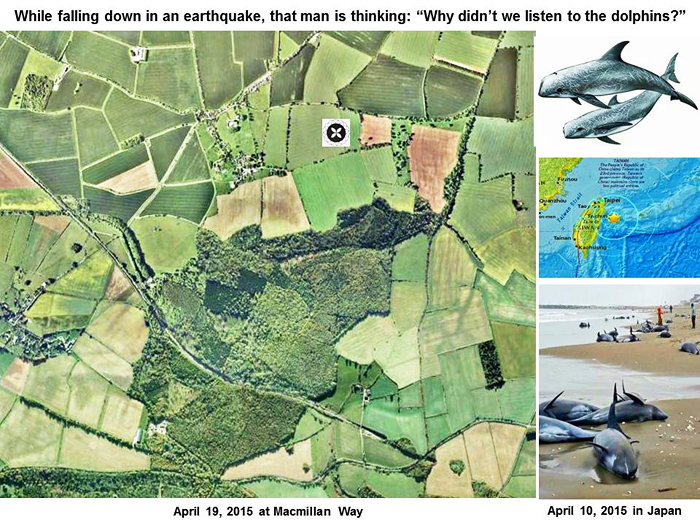
Another
surprise! It was drawn within the somewhat-smaller landscape image
of a “dolphin”. Thus while falling in an earthquake, this distressed
man seems to be thinking: “Why didn’t we listen to the dolphins?”
Ten days
earlier on April 10, 2015, over a hundred melon-headed dolphins died
in a mass stranding along the coast of Japan (see
mass-whale-beaching-fuels-unscientific-japan-quake-fears).
That was the same beach where fifty melon-headed
dolphins died in a mass stranding on March 4, 2011, one week before
the Fukushima earthquake of March 11, 2011. This particular species
of dolphin is very sensitive to faint undersea sound waves, which
may precede a major earthquake.
A “lotus
flower” near the “tail” of a landscape “dolphin”
Looking
more closely at this “flipped over” view, we can see that the new
crop picture near Macmillan Way was drawn near a dolphin’s “tail”:
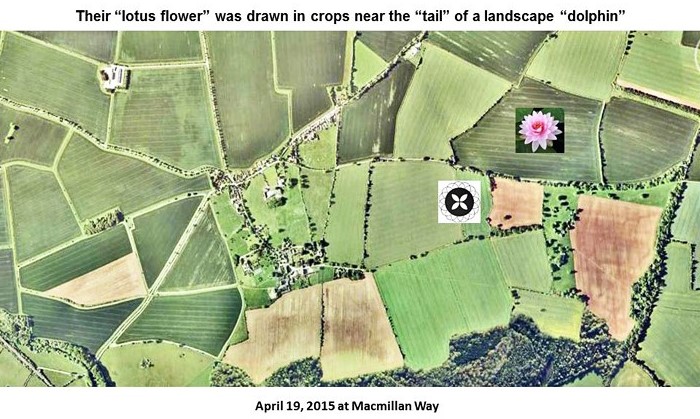
What
could be more beautiful as landscape art? If you download this
“dolphin” slide, and flip it over by 180o, then you can
see their alternative image of a “man eating a lotus flower”.
Very
clever landscape imagery was used at Macmillan Way on April 19, 2015
The
landscape imagery which was chosen for this crop picture was very
clever indeed! On a broad scale, we can see a “Buddhist monk praying
off the coast of China”. When we flip that image over, we can see a
“man falling into a hole during an earthquake”. On a fine scale, we
can see a “man eating a lotus flower”. When we flip that image over,
we can see a “dolphin” with a “lotus flower” near its “tail”.
The 6.6-magnitude earthquake near Taiwan on April 20, 2015 was not
very serious. It caused little loss of property or of human life.
Could there be a second, more powerful earthquake in the same
vicinity soon? Why are the crop artists making so much fuss, over a
minor geological event which barely made worldwide news?
Two related crop pictures from the summer of 2014: dolphins and
earthquakes
Two crop pictures from July of 2014, drawn in the same region of
Gloucestershire, seem to have predicted similar events for April or
May of 2015. Their details are too complex to be shown here, yet we
can summarize their general features. One at Quenington on July 26,
2014 was drawn within the landscape image of a “beached dolphin”.
There was a time-code nearby for “4-1-0” or April 10, when those 160
melon-headed dolphins beached in Japan.
Another at Welsh Way on July 22, 2014 was drawn just above the
“blowhole” of a “melon-headed dolphin” in the landscape. This crop
picture was drawn in the shape of a “keyhole”, to match the
landscape dolphin’s “blowhole”. It also showed three rings (like
“bubble rings” from a dolphin) which matched the orbits of Mercury,
Venus and Earth on April 20, 2015. This was when a 6.6-magnitude
earthquake happened near Taiwan.
Prospects for the future
Whether or not there will be a second earthquake soon, near Taiwan,
remains uncertain. The crop artists seem however to have devoted a
lot of their efforts into describing recent events: a mass dolphin
beaching on April 10, 2015 in Japan, or a minor earthquake near
Taiwan on April 20, 2015. One can only wonder why?
We should study true, non-human-made crop pictures in their
full landscape contexts. Following such an approach, we may
derive more information about their possible meanings. This idea
makes perfect sense, once we consider that such field images could
be the work of extra-terrestrials who remain high in space, while
wishing to view their novel art on the ground!
Finally we can see strong evidence for “time travel”
in certain crop pictures, whether here or in previous examples (see
fringe2015c). Such
field images do not actually “predict” the future, but do seem to
describe accurately what happened, after major historical events
(see also
japantsunami2011). The
likely reality of “time travel” has become apparent from a study of
certain military UFO cases (see for example
fringe2014e).
Red
Collie
(Dr. Horace R. Drew)